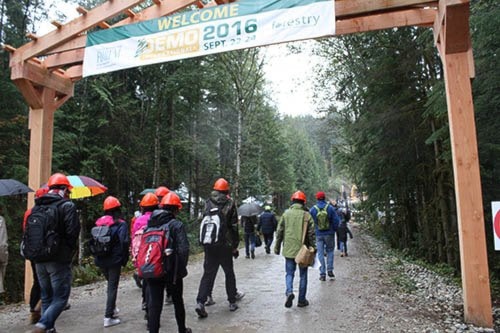Maple Ridge and its 5,000-hectare UBC Knapp Research Forest was on the world stage last week as more than 10,000 people hiked up the roads and looked at the latest in forestry fellers, skidders, and harvesters.
Every four years, the Canadian Woodlands Forum holds a trade show to showcase the latest in logging and forestry and for the first time, it took place in the research forest, perched above Maple Ridge, at the far end of 232nd Street.
"It was a huge amount of work for the staff," said Paul Lawson, director of UBC Research Forests.
While the setting couldn't have been more picturesque amidst the towering rainforest, Lawson was focused on safety risks posed when the public, heavy machinery, huge logs and steep slopes all get into one place.
"Safety-wise, we were very concerned," he said. "We had a lot to manage."
The show was called Demo International 2016 and featured 135 exhibitors such as Caterpillar Forest Products, Canadian Forest Industries and Nokian Tires.
People came from around the world, including Russia, China, Chile and even United Arab Emirates. Lawson though admitted he couldn't guess why someone from the UAE would be interested.
One of the highlights of the show were the harvesting machines tethered on to steep slopes via cable, allowing logging to take place in extreme terrain.
Another aim of the show was to show the general public the latest in forestry technology. While many oppose logging, the improvement in technology is making it easier on the environment.
The new machines are relatively quiet and have less of an impact than previous generations of logging machines.
Air emissions, noise and the amount of ground pressure exerted by machines on the forest floor are all key.
"Fuel economy is a huge selling point for the customers," Lawson said.
The new machines are lighter with larger tracks or tires, allowing better weight distribution and reducing damage to the forest floor.
"If the machines are too heavy and create ruts, they get shut down, and that's not good."
Creating ruts can lead to soil erosion making it difficult to reforest the logged area, said Lawson.
Similarly, the new machines can deftly hoist a heavy log and carry it, rather than drag it, over the ground, minimizing disturbance to the soil.
Then with huge, Terminator-like pincers that operate with the delicacy of a surgeon's tweezers, they can place a log on to a neat pile.
Lawson said the largest three exhibitors likely were Caterpillar, John Deere and Tiger Cat. "They really pulled out all the stops," he said.
One company probably spent a million dollars moving machinery and people to Maple Ridge for the three-day show.
